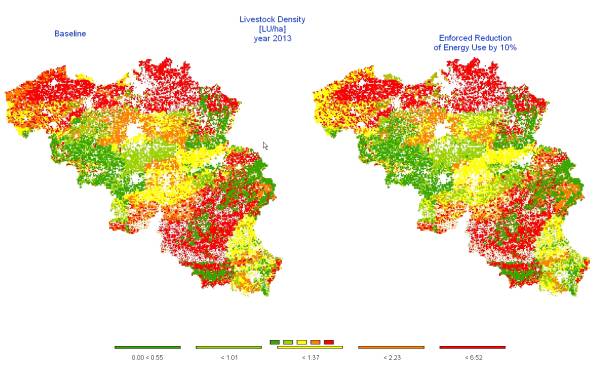Agricultural land use and environmental indicators at 1x1 km grid resolution- derived by spatial downscaling of economic model results
Environmental impact assessment of farm management decisions is often only possible in a spatial context, taking local conditions as land cover, climatic and soil conditions into account. Equally, farm management decisions depend to a larger extent on those local factors. Therefore, CAPRI aims at developping data bases and tools at an appropriate spatial resolution to support monitoring and ex-ante assessment of environmental impacts of agriculture.
 Prospective impact assessment, e.g. of
Prospective impact assessment, e.g. of
- changes in agricultural policies or the farming structure
- of technical progress
- of population growth
- or general changes in the economy as the development of a market for bio-fuels
require combined economic-environmental tools. CAPRI is therefore a component in different research projects (SENSOR, CCAT) developing such tools or combining economic and environmental tools in impact assessment.
The data made presented on those web pages are estimated for so called Homogeneous Soil Mapping Units, clusters of 1×1 km cells covering the agricultural area of the EU27, consistently downscaled from data for administrative regions as comprised in the data base of CAPRI. We offer the possibility to view online selected down-scaled results and indicators derived from them for France.
Indicators characterising impacts of agriculture on the environment:
- Phosphate balance
- Irrigation shares and irrigation water abstraction
all expressed per ha of agricultural land
- Some basic climate and soil parameters, slope and elevation, as major explanatory variables used in the downscaling process
- Selected economic performance indicators
: revenues, variable production costs, gross margins; all expressed per ha of utilisable agricultural land
- Estimates from a statistical meta-model of the bio-physical model DNDC as nitrous oxid emission, nitrate leaching or water transpiration by crops
Methodology
The basic methodology for spatial down-scaling had been jointly developped by the Joint Research Centre and the Institute for Institute for Food and Resource Economics, University of Bonn, to a large extent in the context of the CAPRI-Dynaspat project. The team from JRC comprised members of the AgriEnv action, as well as of the Climate Change Unit. The down-scaled data are produced by statistical estimators for cropping shares, crop yields, animal stocking densities, and fertilizer application rates, starting from the regional data base of CAPRI. The data presented online cover a three year average 2001-2003, but data set had also been projected to 2013 and estimated for counter-factual policy scenarios.
The data and methodology allows the AgriEnv action at JRC-IES to perform environmental impact assessment of the Common Agricultural Policy, both ex-ante as in a forward looking exercises. Agri-Env has in 2007 used the methodology to forecast the probable development of gross nitrogen balances and the share of High Nature Value farmland in the EU up to 2013, in close co-operation with DG-AGRI and the SUSTAG action of IPTS/Sevilla. For 2008, an analysis of impacts of increased bio-fuel production in the EU is planned by down-scaling and analysing results of CAPRI bio-fuel scenarios. Parts of the down-scaled data set are used in large-scale European research projects as SEAMLESS and SENSOR.



